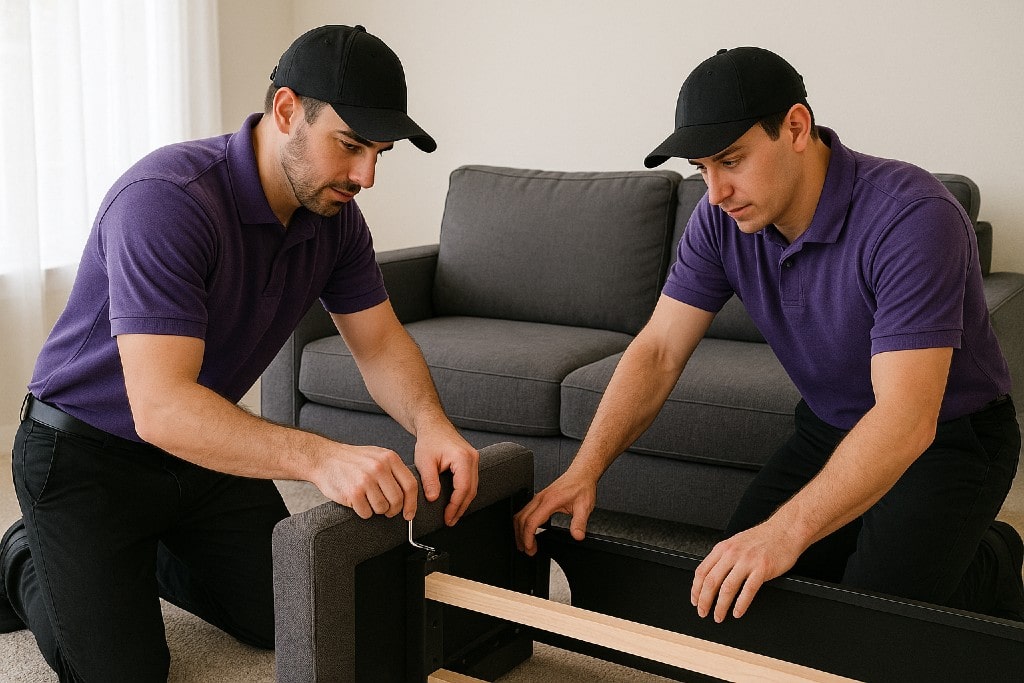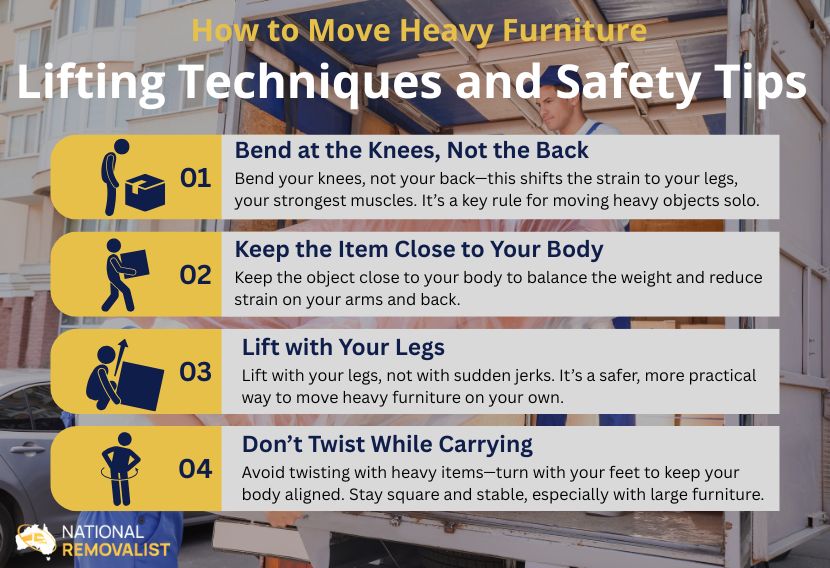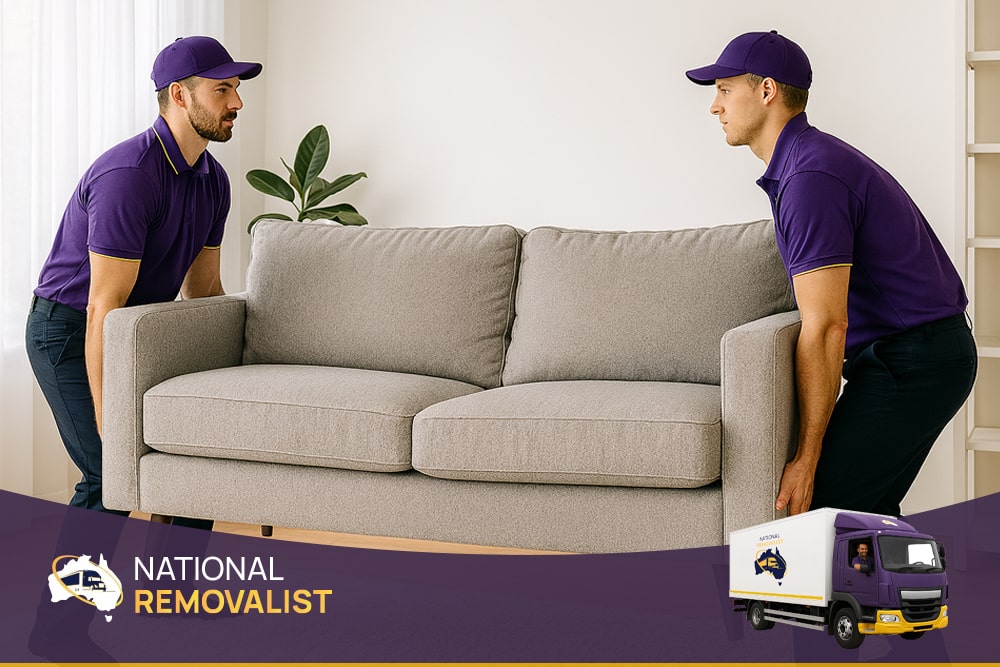Other physically exerting aspects of relocation include moving heavy furniture. It is a big problem getting an item to move from one location to another without breaking or harming that furniture or yourself.
Honestly, we at National Removalist can tell you that the best course of action is to hire professional Sydney movers. With our experience, we know better. Our moving services including our storage for short and long term solutions and packing and moving services can significantly help your moving whether it’s for a local move, a regional one, or even an interstate relocation. We have the equipment to deal with most moving problems.
However, if you’re adamant about knowing how to move heavy furniture by yourself and proceeding with DIY, we can tell you that safety, proper planning, and possessing the appropriate tools are absolute necessities.
Hasty action can mean being hurt, scratching floors, or breaking furniture. However, when you know how to do it properly and have the right equipment, even the heaviest objects may be relocated with ease and minimal risk.
Wondering how to move heavy furniture by yourself, or do you need tips on how to move heavy furniture on a carpet? The guide is intended to be useful to DIY movers, home or renters of houses, as well as anyone who has to move heavy furniture.

How to Move Heavy Furniture: Planning and Preparation
Everyone has at least one large piece of furniture that just needs to be moved somewhere, preferably outside. Learning how to move heavy furniture alone is not so difficult, but it requires some planning and preparation before you begin lifting or sliding anything. When working in a hurry without proper planning, you may end up injuring yourself or damaging walls or furniture.
Measure Everything
Begin by taking measurements of all large furniture, as well as doorways, halls, staircases, and elevators when necessary. Having a pre-knowledge of the dimensions will prevent you from getting stalled midway through the move. If you are thinking about how to move large furniture by yourself around narrow passages singlehandedly, you can not afford to skip this step.
Create a Clear Path
Remove any objects that might get in the way, such as rugs, small furniture, clutter, and tripping hazards. An open space is essential when moving heavy furniture. You will have more control, you will be less distracted, and you can also minimise the risks of damage.
Make a Plan
Plan where you will place each piece. When you are trying to move heavy furniture on a carpet by yourself, then it is doubly imperative that you avoid moving them unnecessarily. Plan your work, prepare your equipment and take one thing at a time. It is efficient, and there is no stress of having to move heavy furniture twice with a plan in mind.
How to Move Heavy Furniture: Must-Have Tools and Supplies
Having proper tools will not only help you move heavy furniture much faster but also without risking injury. These are the necessary pieces of equipment you’ll need, as they can save your body, furniture, and floors from damage.
- Furniture Sliders (Especially for Carpeted Floors): One of the most innovative solutions for moving heavy furniture on carpet by yourself is the use of furniture sliders. These low-friction pads are compact, allowing for the easy movement of furniture on the carpet with minimal effort. All you need to do is put a slider on each corner, and even the heaviest couch can safely and easily roll on your floor, causing no damage.
- Moving Blankets and Straps: Moving blankets are beneficial in cushioning furniture during transportation and reducing the chances of dings, dents, and scratches. The straps are used to hold objects tightly, particularly when transporting them or loading them into a lorry. They also come in handy when preventing drawers and doors from swinging open during relocation. If you’re in need of a moving vehicle, Our Moving Truck Rental service is available.
- Dolly or Hand Truck: A dolly or hand truck is a necessity when attempting to move heavy furniture without straining your back. The weight is transferred to these wheeled tools as you use them to move heavy items with much ease. They come in handy, especially in dressers, bookshelves and appliances like when moving your washing machine and your fridge.
The availability of these tools makes the entire process of moving heavy furniture not only convenient but also very safe.

How to Move Heavy Furniture: Lifting Techniques and Safety Tips
Understanding how to execute the process of lifting heavy furniture without risk of injury is a crucial aspect of moving heavy furniture. Failure to lift correctly is one of the major causes of injury in moving, and it might also cause fall of items or breakage. When it comes to moving heavy furniture without professional help, it is crucial to know how to do it safely to avoid injury to yourself or your furniture.
Bend at the Knees, Not the Back
Bend your knees, not your back. This eliminates tension on your back and transfers the activity to your legs, which are the strongest muscles in your body. This is one of the basic rules that you ought to adhere to on how to move heavy objects by yourself.
Keep the Item Close to Your Body
Carry the object as close to your body as possible to balance it and distribute the weight evenly across your body, taking it off your arms and back. Making it close is also easy to manoeuvre, especially in tight spaces.
Lift with Your Legs
Lift yourself by using the strength of your legs along with the object. A tense jerking movement should be avoided. This is a safer and more practical way of moving heavy furniture that anyone who wants to tackle the challenge themselves can apply.
Don’t Twist While Carrying
It is quite easy to sustain back injuries when turning your body with a heavy piece in the hand. Rather, use your feet by shifting their direction so that your upper body remains straight. When you have large items such as dressers or couches, your main concentration is to stay square and stable.
How to Move Heavy Furniture by Yourself
Moving heavy furniture can be tricky, but with a plan of action, it’s not impossible. Moving heavy furniture is hard work, but regardless of the reason you have to relocate the contents of your house, knowing the best way how to move heavy furniture by yourself safely and without a lot of unnecessary effort will save you time, money, and even accidental injury.
Here’s a practical, step-by-step method for solo movers:
- Empty the Furniture First: Clear out everything that is inside dressers, cabinets or drawers. This not only makes the piece less heavy, but it will also help prevent things from moving and being broken when you are moving. If you’re trying to determine how to move large furniture by yourself, the first vital piece of advice is to lighten the load. If you want, National Removalist can get rid of your clutter. Call us to book our rubbish removal services.
- Disassemble When Possible: Whenever possible, disassemble your large furniture items — remove the legs from a table, the drawers from a dresser, and the cushions or shelves from a couch or shelf. On how to move heavy furniture by yourself, it’s a good idea to break down the pieces into manageable, workable parts.
- Slide, Don’t Drag: When furniture is dragged or pushed directly on the floor, it can break the furniture, as well as the surface. Rather, you can slide by using sliders or raise enough to reposition. This method is particularly beneficial when navigating narrow corners or tight angles by yourself.
Moving heavy furniture is not all about being strong; it is about being systematic, wielding the correct tools or methods, and minimising risk. This easy method on how to move large furniture by yourself will allow you to approach any furniture, even the bulkiest one, securely and independently.
Room-by-Room Moving Strategies
Not every piece of furniture can be transported the same way, which means that something suitable for transporting a coffee table may not be ideal for transporting a king-size bed or a heavy desk. When planning to move heavy furniture by yourself, it’s best to approach each room methodically to save time, protect your home, and minimise the risk of injury. The following are some smart, room-by-room strategies to sort out the most frequent bulky items.
Living Room: Sofas, Entertainment Centres, and Coffee Tables
Most couches and sofas are long, untidy, and cumbersome to move. Begin by removing cushions and legs to cut and weigh down the size. You should strap it down in the case of a fold-out bed on your sofa.
Disassemble the entertainment centres into smaller parts, removing shelves and unplugging the electronics well before moving them. In the case of coffee tables, any glass tops should be pad-wrapped.
On how to move heavy furniture on a carpet by yourself, it is important to bring along furniture sliders designed for use on carpet to minimise resistance and protect your carpet flooring.
Bedroom: Beds, Dressers, and Nightstands
Beds are always a challenge, but when they can be disassembled, it is easy. The first step before disassembling is to remove the mattress, box spring, and, hopefully, the frame. Label the hardware and store it in a bag taped to the pieces of frames to reassemble easily.
Dressers must be emptied to cut the weight. If the drawers are difficult to remove, anchor them in place using moving straps or stretch wraps. Nightstands are normally more manageable, but they still require care, especially if they are made of glass or marble. Make sure to have your clothes packed in a different container.
The art of moving heavy furniture yourself in the bedroom boils down to dividing the task into smaller, easily manageable parts and applying the right lifting techniques that do not strain your back.
Home Office: Desks and Filing Cabinets
The next step is to break down some desks, including legs and detachable tops. In the case of standing desks with electric components, disconnect all electrical parts and wrap the cords with tape.
Filing cabinets should be cleared whenever possible. In small units containing only two drawers, you can leave some of the contents but ensure that the drawers are closed. Whenever a move involves heavier units, it is always better to employ the use of a dolly, especially when you are trying how to move heavy furniture by yourself.
Your approach can vary depending on the type of furniture you are moving. Regardless of the type of furniture you are addressing, specific strategies can be very helpful. When you ask yourself how to move large furniture by yourself, start by dividing the task into manageable pieces, room by room.

When to Ask for Help
It feels good when you are doing things without external help. However, there are instances when all this effort becomes not worth the trouble. When going through the ordeal of moving heavy furniture, it is essential to recognise that there is a limit to what you can handle, and at such times, it is crucial to source an extra hand.
Know Your Limits
Despite having perfected the tricks and even gathered the correct equipment, there is furniture which is still too bulky and cumbersome to transport on your own. Anything involving stairs should raise a red flag. Whenever you’re unsure about how to move heavy furniture by yourself and need to do it soon, this is a sign that it’s time to request assistance.
Avoid Risk of Injury or Damage
The relatively easy task of moving furniture can be transformed into a serious accident, resulting in back strain, pinched fingers, or even dropped furniture. When you attempt to force a relocation when you are not in peak condition or fully equipped, then there is a huge chance of succumbing to serious injuries- let alone the fact that your floors, walls and even furniture will be ruined. Moving heavy furniture very soon may turn hazardous.
DIY vs. Hiring Professionals: Weighing the Cost
Hiring professional movers does come at a price, but the experience, tools and assurance of safety also accompany it. Whenever the burden of repairing broken furniture or treatment of injury is more than the savings that may be incurred, it’s probably worth outsourcing the job.
When you just have a few easy bits to move around, you can probably get away with figuring out how to move heavy furniture by yourself, but when you have more of them that have to be moved on a bigger scale, it would only be wise to hire some assistance.
There’s no shame in asking for assistance. Knowing when to bring in support is part of doing the job right—and doing it safely.

We Will Take Care of the Heavy Work!
The process of moving heavy furniture does not necessarily have to be exhausting. With a proper plan, suitable equipment, and a proper method of lifting heavy items, you can safely handle even the most bulky objects.
Priorities are set on safety. Never be in a hurry; avoid overexertion physically. There are ways to help prevent damage and injury, and one of those ways is to be strategic and cautious.
You now know how to move heavy furniture yourself. You know how to face the challenge with the right ideas in mind. But you know what’s better? Hiring the experts.
At National Removalist, we specialise in moving heavy and oversized furniture with care, precision, and safety. Whether you’re moving house, redecorating, or relocating your office, our experienced team is here to make the process stress-free from start to finish. We bring the tools, the muscle, and the know-how—so you don’t have to go it alone.
Here at National Removalist, we deal in moving heavy furniture with care, precision and safety. Whether you’re moving home or office, our professional, reliable, and experienced team is here to make the entire process as stress-free as possible with our comprehensive moving services. The tools, the muscle, and the know-how we bring ensure that you don’t need to go at it alone.
Don’t risk injury or damage—we will take care of the heavy work.
Contact National Removalist today for a free quote or to book your move. We’re here to help you move smarter, not harder.


